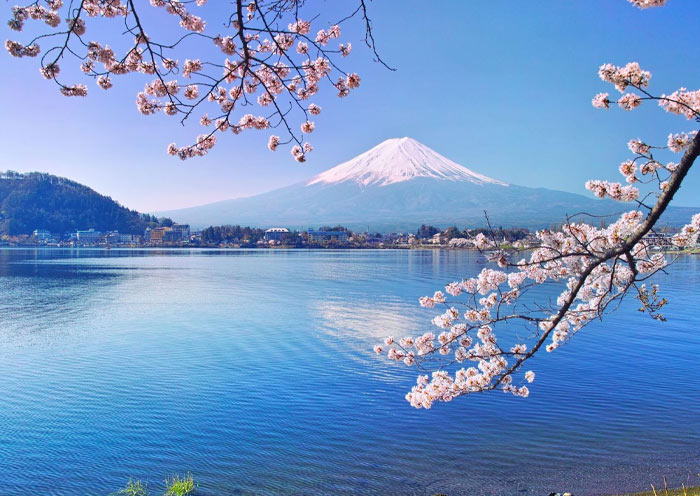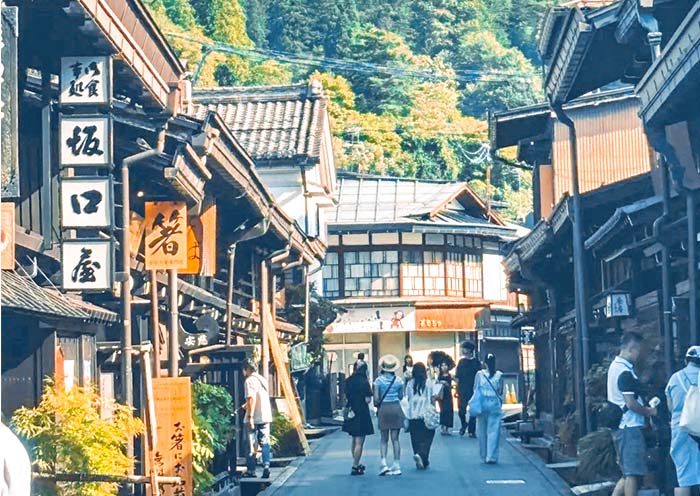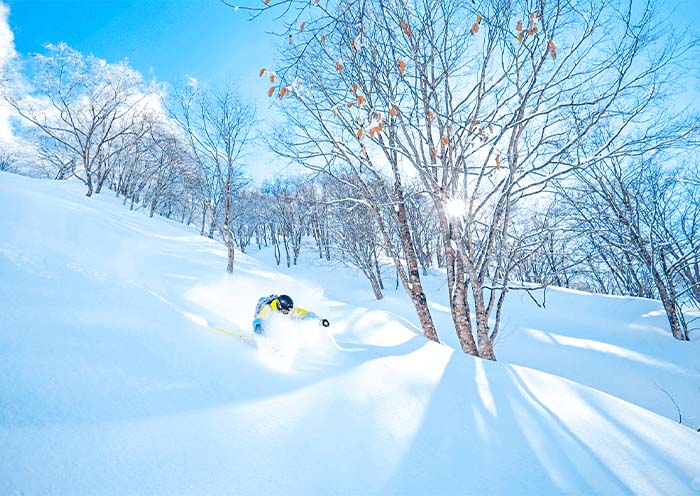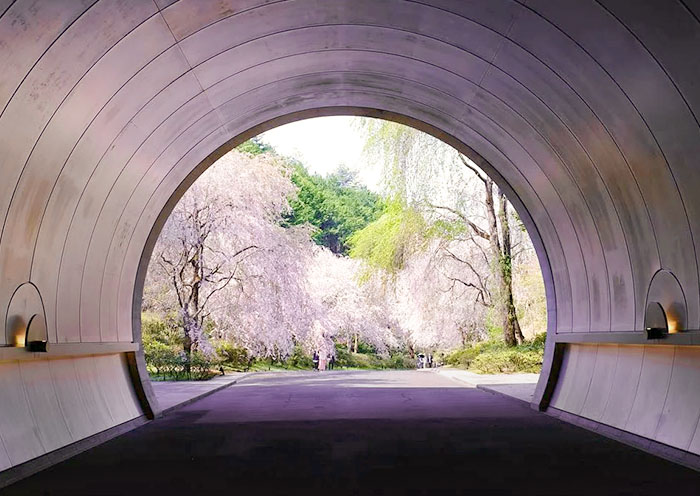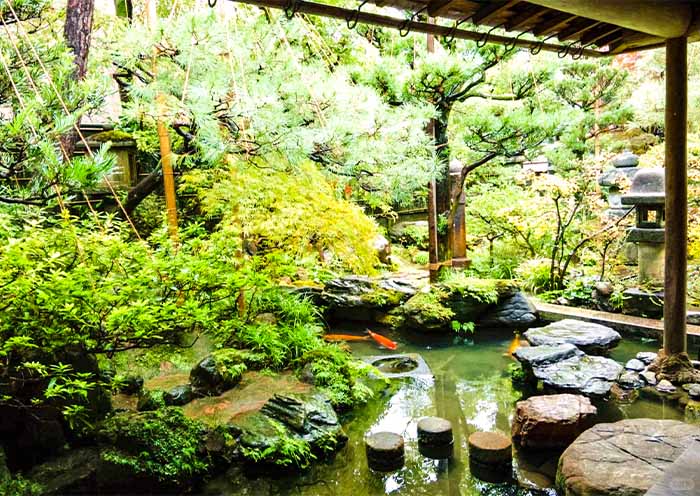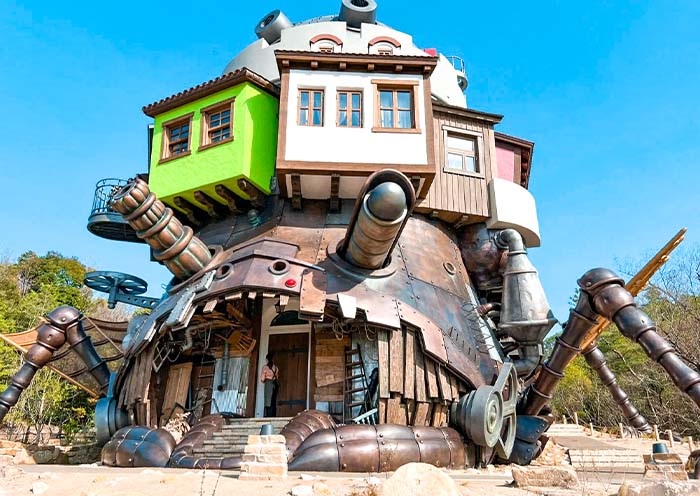12 Days Japan Sakura Tour From Tokyo, Central Japan to Osaka
From
USD request![]()
- This is the price per person, based on a group of 6 people, 4-star hotel accommodation, and travel during the regular season.
- Early-bird rates apply to bookings made at least 6 months prior to the departure date.
- The price is subject to change depending on your travel season, group size, hotel class, and potential fluctuations in currency exchange rates.
- Highlights
- Itinerary
- Price
- Trip Notes
- Accommodation
- Photos
- Reviews
Romantic Cherry Blossom Blooms at 8 Cities, 1 Mountain
Sakura dance with shrines, castles, mountain in a fleeting moment. We're invite you to chase cherry blossom in Spring Japan. Far beyond Tokyo, Kyoto, Osaka! The gentle landscape, also pieced together by a thousand tiny blossoms in serene Central Japan. We take pride in our local service and have carefully crafted 12 Days Japan Sakura Tour for you.
With 12 Days Tokyo Central Japan Osaka Tour, you'll admire classic cherry blossom spots in Tokyo, Kyoto, and Osaka. These include Ueno Park, Senso-ji Temple, the East Garden of the Imperial Palace, and Mount Fuji (Arakurayama Sengen Park). The tour also covers Kiyomizu-dera Temple, Maruyama Park, Kinkaku-ji Temple, and Osaka Castle Park.
You'll also discover more non-touristy but stunning cherry blossom locations in Central Japan, such as Takayama's old streets, UNESCO Shirakawa-go, and Kanazawa's Kenroku-en Garden and Kanazawa Castle Park.
Trending, unique. Your Japan Sakura memory be tinged with pink amid grand World Heritage sites. Come, we're in Tokyo now!
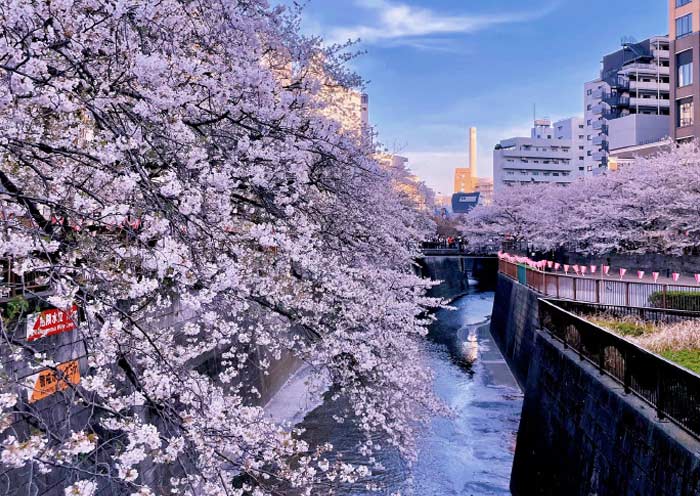


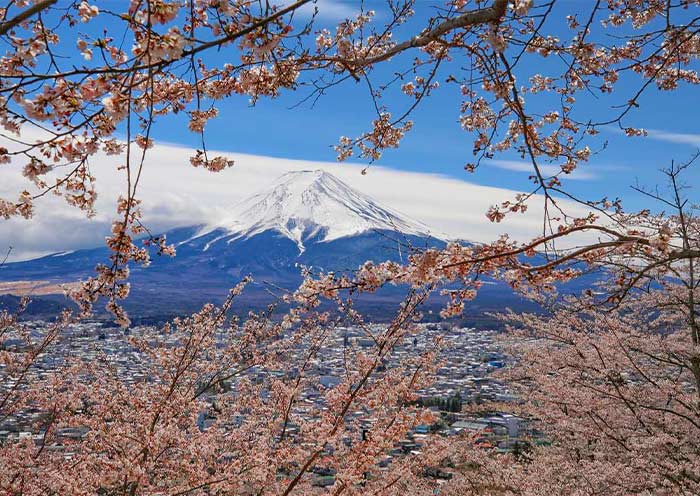



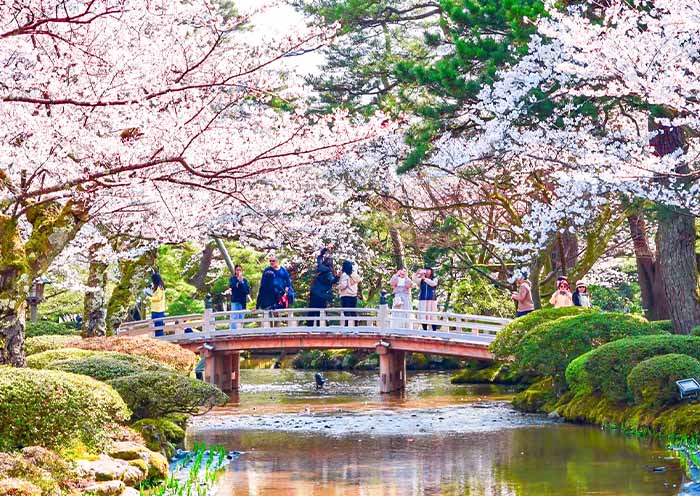
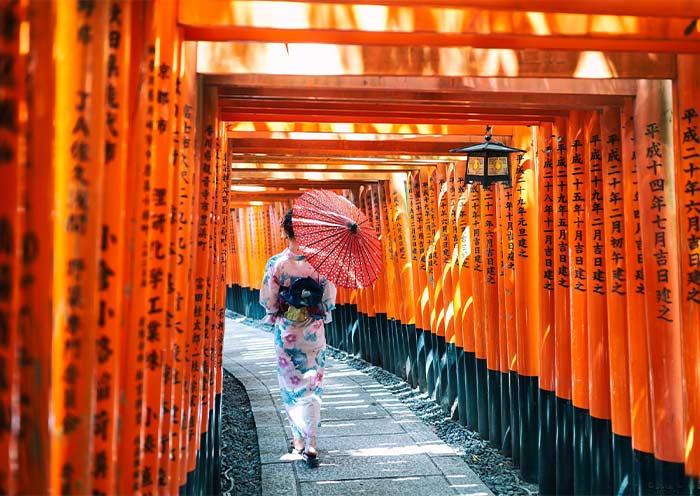


Itinerary at a Glance
Tokyo (3 Days)
Ueno Park (Sakura), Senso-ji Temple (Sakura), East Gardens of the Imperial Palace (Sakura), Tsukiji Fish Market, Meiji Jingu Shrine, Shibuya Crossing, Tokyo Tower
Mount Fuji (0.5 Day)
Arakurayama Sengen Park (Sakura), Lake Kawaguchi
Matsumoto, Japan (1 Day)
Matsumoto Castle (Sakura), Nakamachi Dori, Matsumoto City Museum of Art
Takayama, Japan (1 Day)
Miyagawa Morning Market, Sanmachi Suji District, Takayama Jinya, Spring Takayama Festival (April 14-15) or Takayama Matsuri Yatai Kaikan
Shirakawa, Japan (0.5 Day)
Shirakawa-go (Wada House, Ogimachi Castle Observation Deck)
Kanazawa, Japan (1 Day)
Kenroku-en, Kanazawa Castle Park, Nagamachi Samurai District, Higashi Chaya District, Gold Leaf Work Shop
Kyoto (1.5 Days)
Kinkakuji Temple, Kiyomizudera Temple (Sakura), Ninenzaka & Sannenzaka, Gion, Maruyama Park (Sakura), Fushimi Inari-taisha Shrine
Nara (0.5 Day)
Todaiji Temple, Nara Park (Sakura), Kasuga Taisha, Mount Wakakusa
Osaka (2 Days)
Osaka Castle Park, Shinsaibashi-suji & Dotombori, Osaka Departure
Itinerary Day by Day
Konnichiwa(こんにちは)!Welcome to Tokyo, the capital city of Japan! Upon your arrival at the airport in Tokyo, your driver (not English-speaking) will meet you at the exit and then escort you to the hotel. You can have a good rest in your hotel and get ready to explore Tokyo with your guide the next day.
As one of Japan and Asia's largest economic centers, Tokyo is a hub for Japanese culture and art, with numerous museums, art galleries, theaters, and cultural venues, serving as a vital platform for artistic activities and cultural exchanges. Tokyo stands as a significant base for technological advancement, nurturing numerous high-tech companies and innovative talents, holding leading positions globally in areas like electronics, automotive, and robotics technology.
Situated at the southern end of the Kanto Plain, Tokyo is surrounded by diverse natural landscapes including Mount Fuji, providing residents with leisure and outdoor activity spaces. At one point, the population of the Tokyo metropolitan area reached 36 million, accounting for one-third of Japan's total population. Despite the high cost of living, Tokyo provides residents with convenient living conditions, offering a plethora of shopping centers, entertainment facilities, and a rich culinary culture ranging from fine dining to street food.
Arrival Ideas:
1. Japan has two commonly used international airports. Narita International Airport, located 63.5 km from the center of Tokyo, is the primary international air hub for Tokyo, where flights from China to Tokyo usually land. Tokyo International Airport (Haneda Airport), is situated 17 km from the center of Tokyo and mainly serves domestic flights within Japan and some international flights, including flights to South Korea and other East Asian regions.
2. Cities that have Direct Flights to Tokyo include, but are not limited to: Beijing, Shanghai, Guangzhou, Shenzhen, Hangzhou, Xi'an, Chengdu, Chongqing, Hong Kong, Taipei, Kaohsiung, Seoul, Singapore, Bangkok, Kuala Lumpur, Jakarta, Bali, Manila, Ho Chi Minh City, Hanoi, and more. Please note that flight information is subject to changes based on time and market demand. Contact us to obtain the latest flight information and prices.
3. In Japan, using public transportation such as the Subway JR trains is Recommended to save costs, avoid traffic congestion, and help reduce carbon emissions. Taxi Fares in Japan are relatively high, with a starting fare of around 660 Japanese yen and 140 yen per km. Waiting time is also charged. Surcharges are applicable during nighttime and peak hours (+20%), and expressway tolls are additional. Extra fees are levied for large luggage. For instance, a taxi ride from Tokyo Tower to Narita Airport, covering about 60-70 km,might cost around 25,000-35,000 Japanese yen (roughly 170-237 USD).
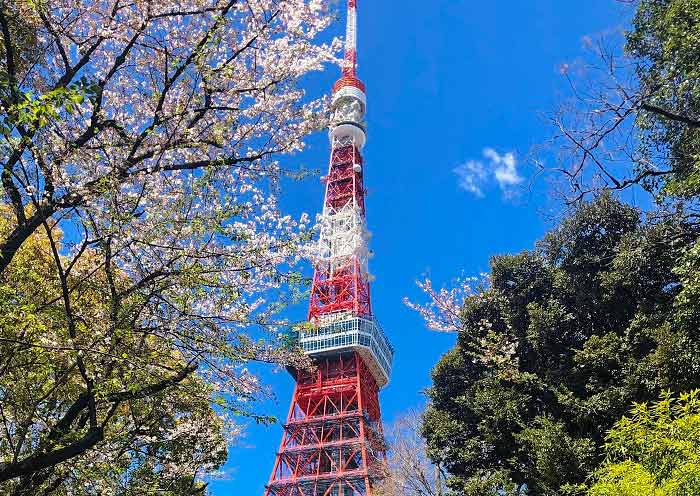
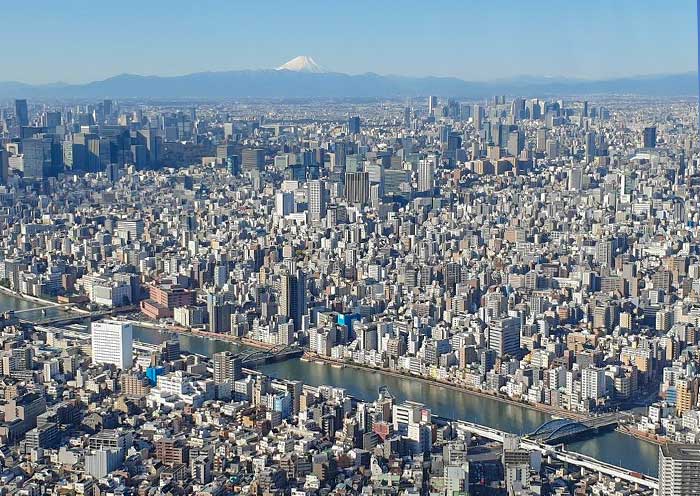
Full day explore Tokyo & Sakura (Cherry Blossom). You will visit Ueno Park, Senso-ji Temple (a Buddhism Temple; view Tokyo Skytree), East Gardens of the Imperial Palace (or Imperial Palace Plaza) & Tsukiji Fish Market.
In the morning head to Ueno Park. It is one of the city's largest parks and one of Japan's most famous cherry blossom viewing spots, boasting over 1,300 cherry trees. The cherry blossoms typically reach their peak bloom in late March to early April. The park transforms into a stunning sea of pink and white flowers, creating a perfect backdrop for photos and leisurely strolls.
In the afternoon, head to Senso-ji Temple (Asakusa Kannon Temple), a must-visit for anyone traveling to Tokyo. Here, you can experience the heart of old Tokyo and its vibrant atmosphere. You can take photos that frame Senso-ji Temple and the Tokyo Skytree (Japan's Tallest Tower; 634 meters) together. Senso-ji Temple is a great place to view cherry blossoms in Tokyo! The temple is located in Asakusa, a popular neighborhood known for its cherry blossoms. There are several cherry trees in the temple grounds, as well as in the surrounding area.
Senso-ji Temple was built in 628 AD and has a history of over 1300 years, making it one of Japan's oldest temples. It not only witnesses Japan's historical changes but also carries a rich Buddhist culture. The architectural style of Senso-ji Temple blends Japanese traditional culture and art, with rich colors and exquisite carvings. The main buildings include the main gate (Kaminarimon; a landmark of Tokyo), the bell tower, the five-story pagoda (a landmark of Tokyo), and the main hall, all reflecting ancient Japanese architectural style and religious beliefs.
Kaminarimon is the iconic structure of Senso-ji Temple, towering at 11.7 meters high and 21.7 meters wide, truly spectacular. Giant red lanterns hang in front of the gate, with the words "Kaminarimon" prominently displayed. Kaminarimon is not only a symbol of Senso-ji Temple but also one of Tokyo's most famous landmarks. You may have seen the work of Utagawa Hiroshige, one of the "Three Greats of Ukiyo-e," in his piece "One Hundred Famous Views of Edo: Asakusa Kaminarimon," depicting a snowy scene of the Kaminarimon gate, celebrated for its delicate portrayal and profound imagery, becoming a masterpiece of Ukiyo-e art. The area is bustling, and crowded with people coming to pray and seek blessings for health, peace, and happiness. Around Senso-ji Temple, you can taste various Japanese cuisines, purchase unique souvenirs, and participate in various celebratory activities.
After that, visit East Gardens of the Imperial Palace (Closed on Mondays, Fridays, and holidays). The gardens are home to several varieties of cherry trees, including Somei Yoshino, Yamazakura, and Shidarezakura. The blossoms typically bloom from late March to early April. It is a beautiful royal garden with grand courtyards, elegant ponds, lush flowers, and verdant trees that create an atmosphere akin to a fairy tale world. Strolling through here provides a glimpse into the daily life scenes of the Japanese Imperial Family.
You will not miss the Two-tiered Bridge (Ni-ju Bashi Bridge), one of the iconic landmarks of Tokyo, attracting numerous domestic and international visitors who come to admire and take photographs. Located in front of the main gate of the Imperial Palace & spans the inner moat, the Ni-ju Bashi Bridge is not only a symbol of the Imperial Palace but also a microcosm of Japanese culture and history. As the bridge where ambassadors from various countries present their credentials to the Emperor of Japan, the Nijubashi Bridge has witnessed numerous crucial diplomatic moments. The name "Nijubashi" originates from its unique structure. Due to the deep moat and the low height of the old bridge, a second bridge was constructed above the original one, creating a double-layered appearance, hence the name "Nijubashi."
Note:
1. If Imperial Palace East Gardens are not available, you can visit Imperial Palace Plaza (Imperial Palace National Garden) and Two-tiered Bridge which are open to the public.
2. Imperial Palace Plaza - The Outer Gardens of the Imperial Palace serve as a public park for the citizens of Tokyo, featuring vast green spaces and meticulously trimmed cypress trees. During spring, the cherry blossoms bloom here, making it one of the renowned cherry blossom viewing spots in Tokyo.
You can also visit Tsukiji Fish Market which is a popular place to view cherry blossoms in Tokyo. It was once the world's largest fish market, famous for its tuna auctions. However, in 2018, it relocated to a new, larger facility called Toyosu Market. You can still enjoy fresh seafood (sashimi, sushi, or seafood rice bowls), purchase kitchenware, and learn about a variety of seafood, including the characteristics, cooking methods, and nutritional value of different types of seafood.
Optional Acitivity: Meguro River (Nighttime Cherry Blossoms Viewing)
For a unique and enchanting cherry blossom experience, visit Meguro River in the evening. This picturesque location isfamous for its stunning night sakura, where the cherry trees along the river are illuminated after dark, creating amagical and serene atmosphere.
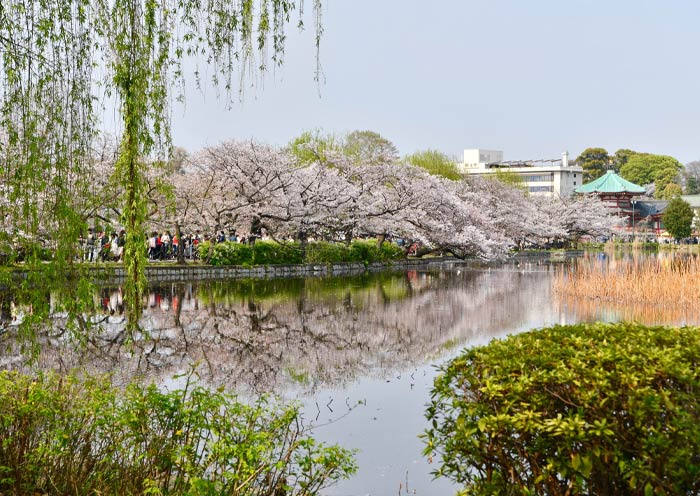
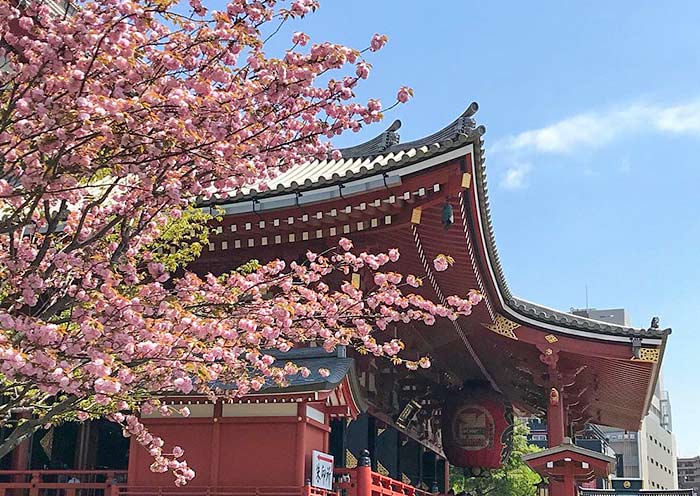
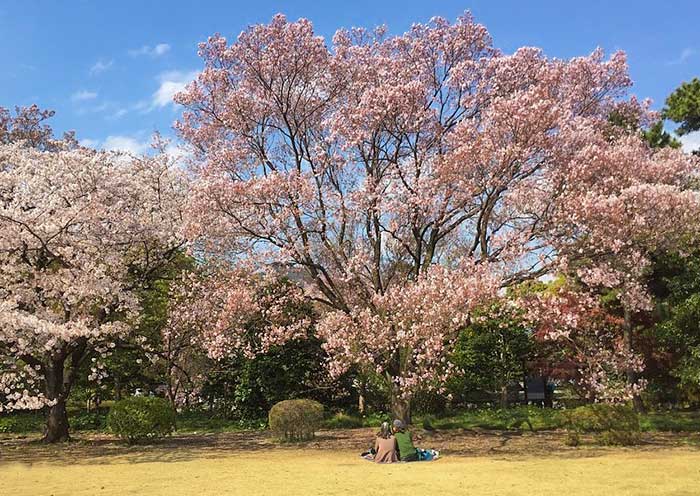
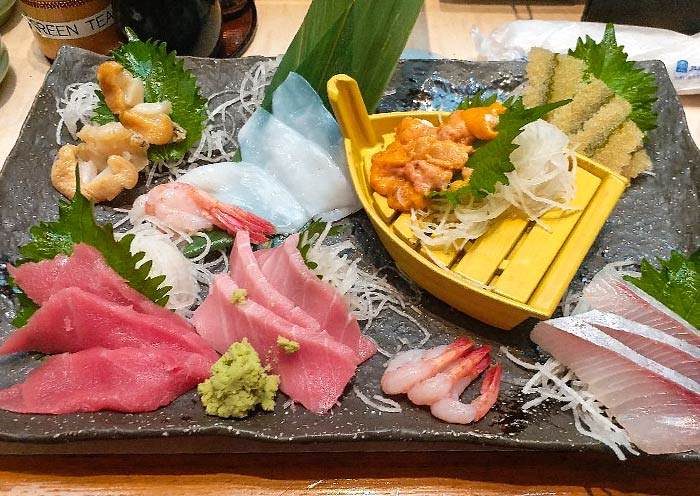
Full day explore Tokyo & Cherry Blossom. You will visit Meiji Jingu Shrine (a Shinto Shrine; meet Japanese wedding procession), Shibuya Crossing (Hachiko the loyal dog Statue), Zojo-ji Temple & Prince Shiba Park (Sakura). If time permit, you visit Tokyo Tower (Optional).
First to visit Meiji Jingu Shrine (Meiji Shrine), a Shinto Shrine dedicated to Emperor Meiji (1852-1912) and Empress Shoken (1849-1914), who played a crucial role in modernizing Japan while excelled in writing Waka (traditional Japanese poems of 31 syllables in the pattern 5-7-5-7-7). Meiji Shrine is a popular venue for traditional weddings, where you will have the opportunity to witness a Japanese Wedding Procession, experiencing the charm of Japanese traditional culture.
Founded in 1915 and finished in 1920, Meiji Shrine features a unique architectural style, with the main hall adopting traditional Japanese Shinto Shrine architecture infused with modern elements in its details. You will walk through Japan's Largest Wooden Torii Gate, standing in its natural wooden hue and weighing up to 13 tons. The Torii gate serves as the Symbol of Shinto Shrines, marking the transition from the worldly to the sacred. Walking through this gateway symbolizes stepping into the divine realm, evoking a profound sense of mystery and reverence.
As a peaceful oasis in the city, Meiji Jingu Shrine is the largest green space in the center of Tokyo. In the land-scarce city of Tokyo, the vast area occupied by the Meiji Shrine is truly astonishing! The sacred forest (170,000 trees) surrounding the main shrine buildings of Meiji Jingu is man-made, planted by 110,000 volunteers in honor of their beloved Emperor Meiji (established Shinto as the state religion) and Empress Shoken. The forest serves also to separate the sacred from the profane world.
Take a stroll along the paths and enjoy the fresh air and natural beauty. Then, you will notice the impressive Sake Barrel Wall along the South Approach, which features offerings from sake breweries and believers across Japan, including barrels of sake and Western liquor, reflecting Emperor Meiji's fondness for Western culture. At the main hall of Meiji Shrine, you can witness locals washing their hands and rinsing their mouths at Purification Font before worship as a sign of respect. You can offer a 5-yen coin (symbolizing a connection) like locals and pray for blessings. In the eyes of the Japanese, Meiji Shrine is considered to have such boundless capabilities, from naming ceremonies for newborns, to coming-of-age ceremonies, graduation ceremonies, seek marriage partners, pray for world peace, family well-being, safe travels, good health, warding off calamity, etc. In addition to immersing yourself in Japanese Shinto traditions and architecture, revel in the enchanting surroundings filled with lush trees, serene ponds, graceful bridges, and stone pathways that epitomize the essence of traditional Japanese Garden Art. You should visit here to enjoy the vibrant bloom of cherry blossoms in spring, the verdant beauty of summer, the fiery hues of autumn leaves, and the serene snowy landscapes of winter.
Tips for Visiting Meiji Jingu Shrine:
1. Wear modest clothing: Respect the sacred nature of the shrine by dressing appropriately.
2. Be mindful of noise levels: Maintain a quiet and respectful atmosphere.
3. Inner Garden (Optional; self-pay;once Imperial Property), and Meiji Jingu Museum (Optional; self-pay;items used by the imperial couple).
Then, move to visit Shibuya Crossing, one of the busiest intersections in the world, accommodating approximately 3,000 people per minute. As one of Tokyo's iconic locations, Shibuya attracts tourists and photographers from around the globe who come to observe and capture its essence. Numerous movies, TV shows, commercials, and music videos are filmed at this location, such as "Detective Chinatown 3" and "The Fast and the Furious: Tokyo Drift." Additionally, the well-known story of Hachiko the loyal dog originates here. Hachiko, an Akita dog, continued to visit the station daily to await his deceased owner's return. The Hachiko statue located in front of Shibuya Station stands as a significant cultural landmark in the Shibuya area, attracting numerous visitors annually who come to pay their respects and honor his loyalty.
Lastly, visit Tokyo Tower , inspired by the design of the Eiffel Tower, is a beloved landmark of Tokyo offering a unique view of the city, especially during cherry blossom season. The observation decks provide stunning panoramic views of Tokyo's iconic skyline & if weather permits you can even view Mt. Fuji. During cherry blossom season, the city transforms into a sea of pink Sakura. Tokyo Tower also hosts special events and attractions related to the popular anime series "One Piece," adding to the excitement of your visit (need to check with Tokyo Tower). At night, the tower's illuminated appearance, combined with the city lights and cherry blossoms, creates a magical atmosphere.
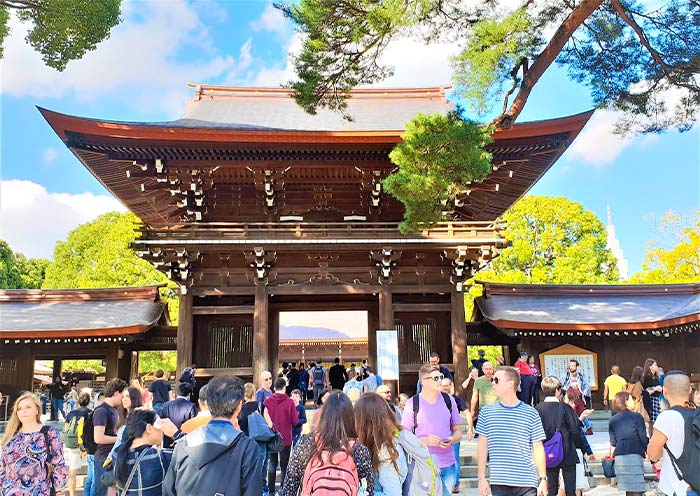
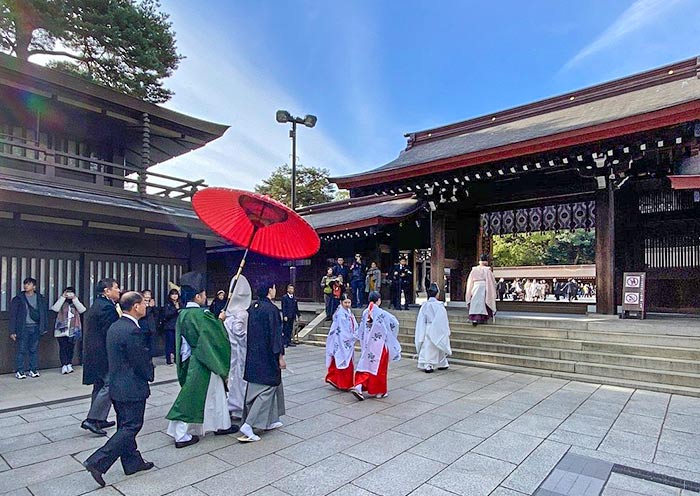
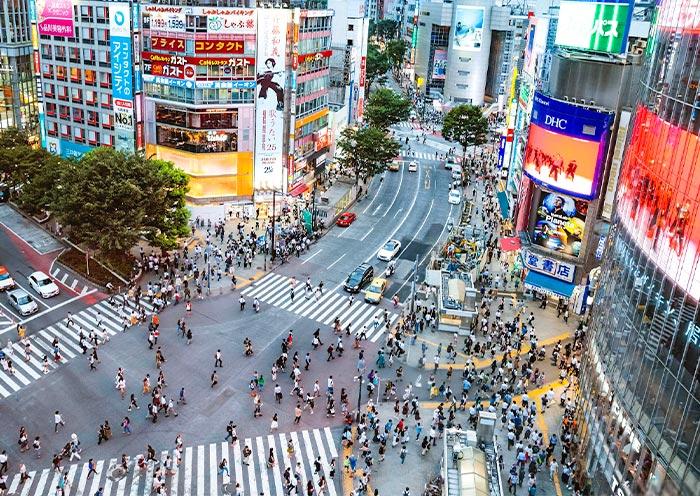
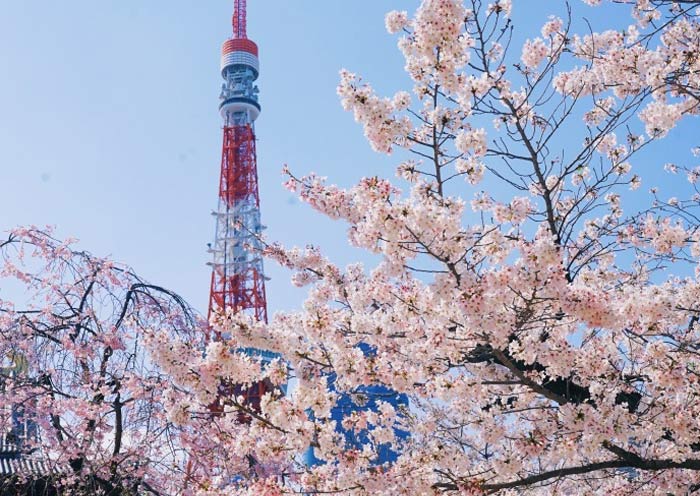
Today, admire the breathtaking views of Mount Fuji from the Arakurayama Sengen Park, Lake Kawaguchi. Stay overnight at Matsumoto.
Mount Fuji is the tallest mountain in Japan. It's a famous volcano with a perfectly symmetrical cone shape. Visiting Mount Fuji is essential for any traveler in Japan. As a UNESCO World Heritage Site, Mount Fuji (3,776m) stands as an iconic symbol of Japan, a cultural and spiritual landmark (recognized as a holy mountain in Shintoism), and a natural marvel. When picturing Mount Fuji, its distinctive perfect cone shape and snow-capped peak likely come to mind. Among the most renowned depictions is Katsushika Hokusai's 'Thirty-Six Views of Mount Fuji'. Hokusai, one of the "Three Greats of Ukiyo-e," is best known for his masterpiece "The Great Wave off Kanagawa" which can be seen on the 1,000 Japanese yen bill.
Start your journey to Arakurayama Sengen Park on the way to Lake Kawaguchi. Arakurayama Sengen Park is a popular destination for viewing cherry blossoms, renowned for its early blooming sakura trees. The park features Kawazu zakura, a unique variety of cherry trees known for its large, pink blossoms. The park's cherry trees typically bloom earlier than those in other regions of Japan, making it a great choice for those who want to experience the beauty of Sakura in February or early March. The park offers breathtaking views of the Kawazu River and surrounding mountains (framing Mt. Fuji, Sakura & Five-story pagoda together), providing a picturesque backdrop for your cherry blossom experience. During the peak cherry blossom season, the park hosts a lively festival with food stalls, traditional performances, and other festivities.
Then, head to Lake Kawaguchi for a leisurely walk along the lakeside. Lake Kawaguchi is renowned for its clear waters that often reflect the majestic Mount Fuji (if weather permits), creating a postcard-perfect scene and making it a popular destination for both domestic and international tourists.
In the afternoon, a 3-hour car ride will take you to Matsumoto for hotel check-in. It is the gateway city to the Northern Japan Alps and a popular spot for viewing cherry blossoms, particularly the weeping cherry trees whose drooping branches bloom like pink waterfalls.
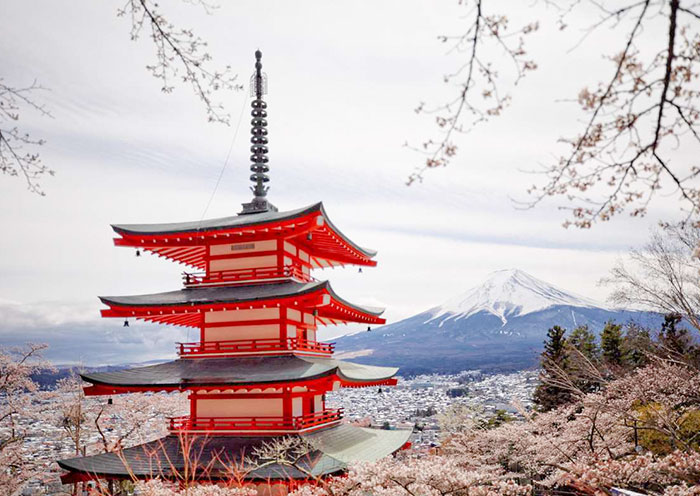
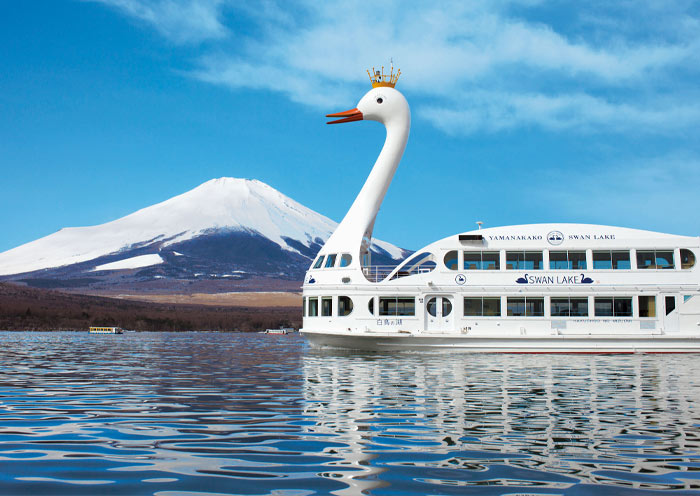
We’ll be in Matsumoto all day for castle, old street and art museum.
First, visit Matsumoto Castle. In spring, the castle becomes a prime spot for weeping cherry blossom viewing, with the park and moat lined with blooming sakura trees.
Matsumoto Castle is a National Treasure of Japan and a must-visit to experience the architectural style of Japan's Warring States period. Built between 1592 and 1614, its black exterior appears majestic and solemn, earning it the local nickname "Crow Castle." It is unique for sharing, with the famous Himeji Castle, the rare "five-storied, six-leveled keep" structure—appearing five stories from the outside, but having six internal floors.
You can enter castle's main keep and climb its steep wooden stairs, encountering wartime features such as trap doors, armor, and robust construction along the way. At the top, enjoy panoramic views of Matsumoto Castle Park, the city, and surrounding mountains. Stand where feudal lords once surveyed their domains—the peak of power in ancient Japan. (P.S. Please climb carefully.)
Second, head to Nakamachi Dori, the historic downtown commercial district of Matsumoto Castle during the Edo period. An ancient CBD. Once renowned for sake breweries, soy sauce shops, pharmacies, and silk production, the street preserves architecture from the Edo to Taisho eras, characterized by white walls, black latticed windows, and heavy tiled roofs. Here covers historical charm and everyday life, with a wide array of traditional crafts, ceramics, lacquerware, and curio shops. Relax and glimpse Matsumoto’s cultural lifestyle, come here.
Third, step inside Matsumoto City Museum of Art, one of the city's cultural landmarks. As the birthplace of Yayoi Kusama, one of Japan’s most internationally influential contemporary artists, Matsumoto has become a pilgrimage site for Kusama fans worldwide. At museum’s entrance stands "Gen no Hana" (Phantom Flower), a 10-meter-tall tulip sculpture—Kusama’s specially created, largest outdoor polka-dot artwork for the museum’s opening. Polka-dot enthusiast or not, the museum’s permanent Kusama exhibition is well worth a visit. Captivating paintings, endlessly reflective "Infinity Mirror Rooms”. Tour same sights, but experiences vary.
After the tour, stay overnight at a hotel in Matsumoto.
Free Time Idea: Matsumoto (Nighttime Cherry Blossoms Viewing)
From early to mid-April, Matsumoto Castle hosts a Night Cherry Blossom Festival from 5:30–9:00 PM. As one of Japan's most beautiful night sakura spots, the castle is most stunning at dusk when the blossoms and castle are illuminated together. You might also catch a traditional music performance or a tea ceremony.
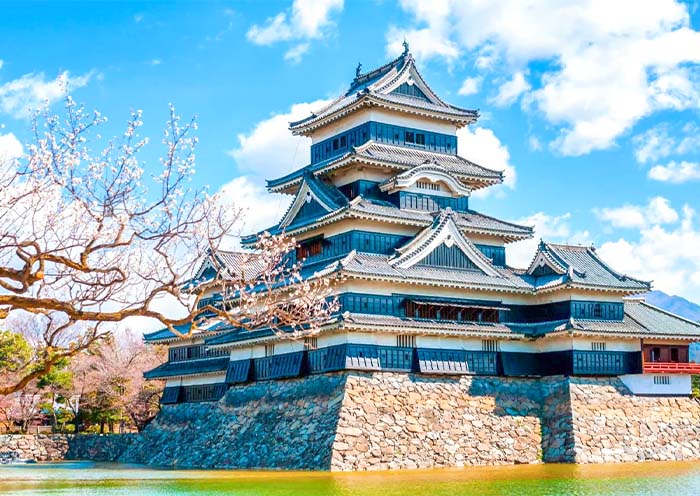

After breakfast, you'll take a 2-hour drive to Takayama for a full-day tour of its old streets. It's a serene city dotted with vast fields of Somei Yoshino cherry blossoms blooming along the riverbanks.
First, visit Sanmachi Suji District, heart of Little Kyoto in Takayama. It is the city's most iconic historic district. Its three ancient streets—Ichinomachi, Ninomachi, and Sannomachi—have preserved the essence of the Edo to Meiji periods. As you stroll, you'll admire buildings that still retain their original charm: black wooden exteriors, lattice windows, and noren curtains hanging under the eaves.
Take your time to wander and savor Hida beef (Self Pay), which melts in your mouth and rivals Kobe. Sake breweries, sweet shops, and more to check. This area isn't crowded. The ordinary people have lived here for generations. With blue sky overhead and black wooden houses below, you'll be gazing at the same timeless scenery as ancient Japanese people.
Then, 4 minutes walk to Takayama Jinya, the only surviving Edo-period magistrate's office in Japan. Established in 1615, this former Tokugawa Shogunate administrative center for Hida integrated offices, storehouses, a courtroom, and courtyards. Get inside, it's fascinating to observe the wooden structures, bamboo torture instruments, and even exposed nails crafted into rabbit patterns.
Turn to outdoor activities. If time permits, visit Takayama on April 14 or 15 to attend the Spring Takayama Festival amid blooming sakura.
It is one of Japan's three most beautiful festivals, held every spring and autumn. The spring event perfectly coincides with cherry blossom season.
Its main attraction is the huge, 8-meter-tall floats, which are a feast for the eyes, covered in shining gold, lacquer, and copper decorations. At 10 AM and 2 PM, puppets on the floats perform lively 50-minute shows.
The highlight is the procession of portable shrines in the afternoon and evening. Locals parade through town with shrines, which hold the local god, while playing traditional music. With exquisite floats, cherry blossoms everywhere, and passionate locals protecting the festival, it's a truly memorable experience.
Have fun! If you miss the festival dates, you can visit Takayama Matsuri Yatai Kaikan to admire the yatai year-round.
Stay overnight in Takayama.
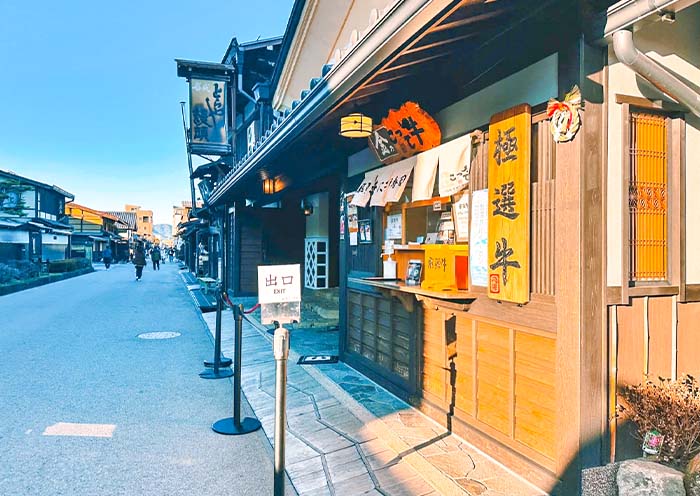
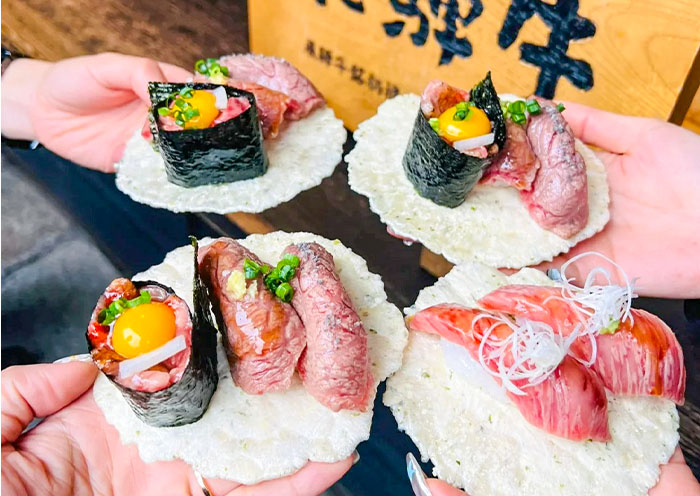
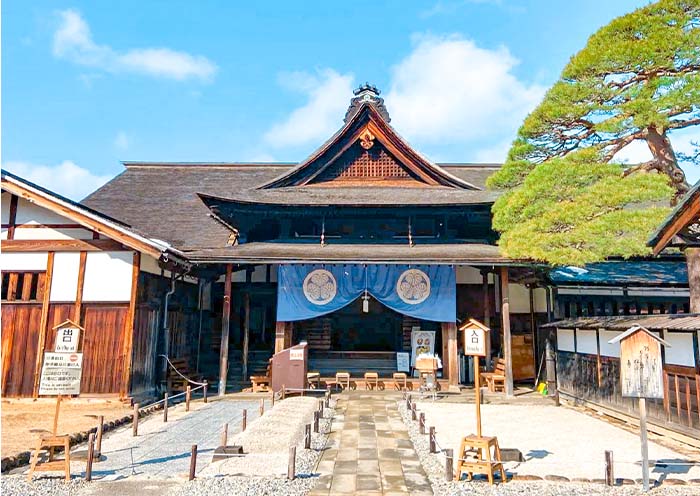
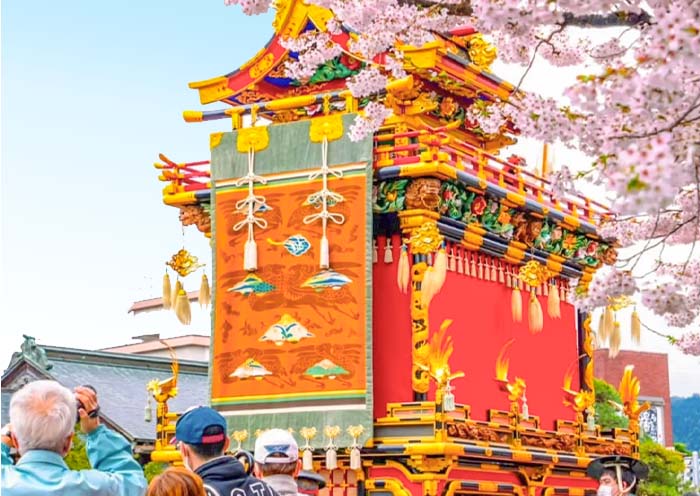
Spend a full day exploring Takayama, Shirakawa-go to experience traditional Japanese culture and heritage.
Start your morning at 300-year-old Miyagawa Morning Market, one of Japan's three great morning markets. Join locals as they begin their day. This traditional market stretches for about 350 meters along the riverside, featuring over 60 stalls. It's hard to attend this kind of traditional Japanese markets as many others gradually disappear. You can leisurely browse local fruits and vegetables, pickles, crafts, and snacks. Feel the warmth and vibrancy!
After that, take a 1-hour car ride to Shirakawa-go. Spend a half day in Japanese traditional village.
Shirakawa-go, famous for its large collection of preserved 17th-century Gassho-zukuri farmhouses, has been a renowned UNESCO World Heritage site since 1995, celebrated for its untouched natural beauty. The thatched roofs of these traditional houses are steeply pitched at a 60-degree angle, resembling hands clasped in prayer—hence the name "Gassho-zukuri" (praying hands construction). Local residents developed this three-story design to withstand heavy snow. The lower floors are for living, while upper levels for storing hay or raising silkworms.
This pristine village shows a clear, beautiful scene that seems to keep worries at bay. In cherry blossom season, the Somei Yoshino cherry trees in the village are not crowded like they are in other places, but they possess a solitary beauty. The blossoms seem to lean against houses, their branches stretching out boldly.
Beyond admiring the village from outside, you can visit Wada House, the headman's residence, to check the interior of a Gassho-zukuri home. Gassho-zukuri house in the village and offers the best views. The ancient thatched roof keeps the interior warm in winter and cool in summer. As you ascend the stairs, the upper floors display traditional farming tools and old photos of daily life and silkworm farming. From the windows, the mountains and village seem almost within reach.
After exploring the Wada House, head to Ogimachi Castle Observation Deck, the best spot to overlook the entire Shirakawa-go village. A view will likely inspire you to take countless photos.
After the tour, drive 1 hour to Kanazawa for hotel check-in.
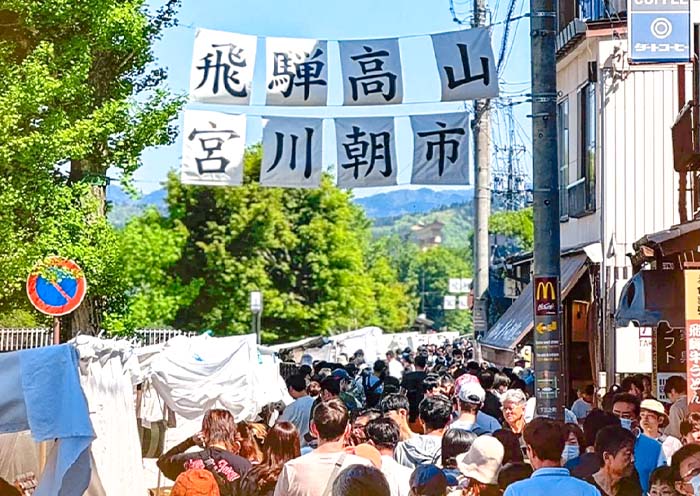

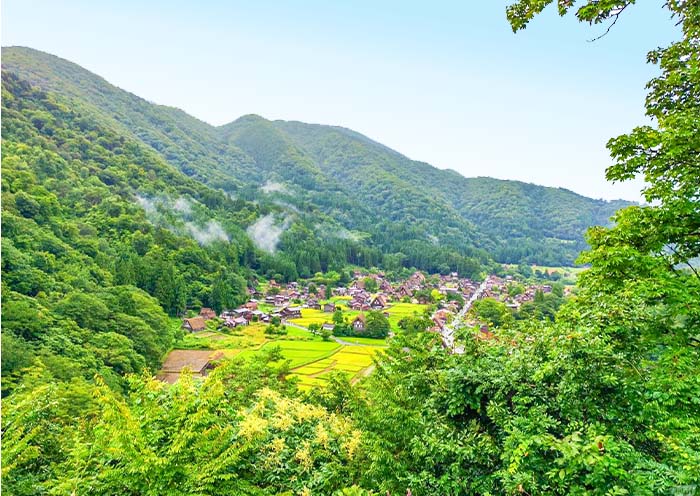

Take a whole day in Kanazawa for its traditional Japanese garden, castle, samurai culture, and golden leaf artisan DIY.
First, explore Kenroku-en, Kanazawa's iconic garden and one of Japan's top three. It shows off the best of Japanese garden art. This garden, built in the 1600s by the Maeda noble family and opened publicly in 1871, blends spaciousness, tranquility, artistry, ancient vibes, water features, and great views along its winding paths.
Inside through Mayumizaka Gate, the biggest highlight is Kasumigaike Pond, where you'll find famous Kotojitoro Lantern with one leg in water, one leg on bank. Nearby is unique Neagari-no-Matsu (Root-lifting Pine), with its roots impressively exposed. At Hanami-bashi Bridge, a swarm of Somei Yoshino cherry blossoms awaits you. And, rest at Shigure-tei Tea House, a former noble resting spot, where you can enjoy matcha and sweets. Look back, stunning garden views pour in through its open doors.
Second, head to opposite Kanazawa Castle Park, Kanazawa's historical center. This expansive park encompasses famous Kanazawa Castle, once home to the Maeda family, powerful Edo-period feudal lords. The relics, also adorned with cherry blossoms, still echoes grandeur of rulers from centuries past.
You will explore key areas like the Hishi Yagura (a rhomboid-shaped watchtower showcasing castle's defense layout and wooden construction techniques), the Gojukken Nagaya (a 90-meter long armory and soldiers' barracks). This is your place to glimpse Edo-era castle and samurai.
Got a satisfying meal, then, drive to Nagamachi Samurai District. It’s a precious relic of Japan's samurai culture, a core district where upper-ranking Edo-period samurai. Its narrow, rustic streets are lined with shoulder-high earthen walls and wooden buildings. The Nomura House exemplifies samurai life. Here, the house, pond, tree, stone lantern meet in perfect embrace. Sit, listen, or view from the second-floor tea room. An ideal spot to revitalize energy.
Next, explore Higashi Chaya District, Kanazawa's iconic old street often compared to Kyoto's Gion. Built in the 1800s, this area once hosted samurai enjoying tea and geisha performances, and over 20 original Edo-era buildings still line. You can experience Edo-period high society at Shima Teahouse with tea and sweets, and be sure to try gold leaf ice cream. Finish your day at a Gold Leaf Workshop for a fun DIY project. Gold Leaf always ranks No. 1 when it comes to Kanazawa's specialty. Give it a try. You'll pick a mirror or chopsticks, mask it under the helpful of instructors. Create your golden art.
After the tour, take 2 hours train to Kyoto for hotel check-in.

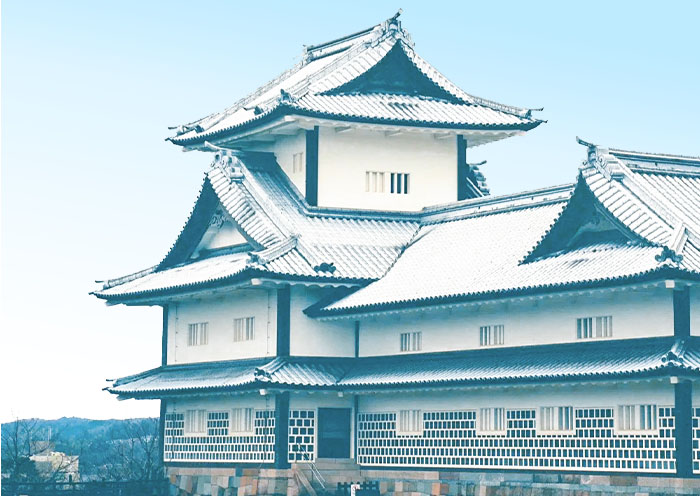

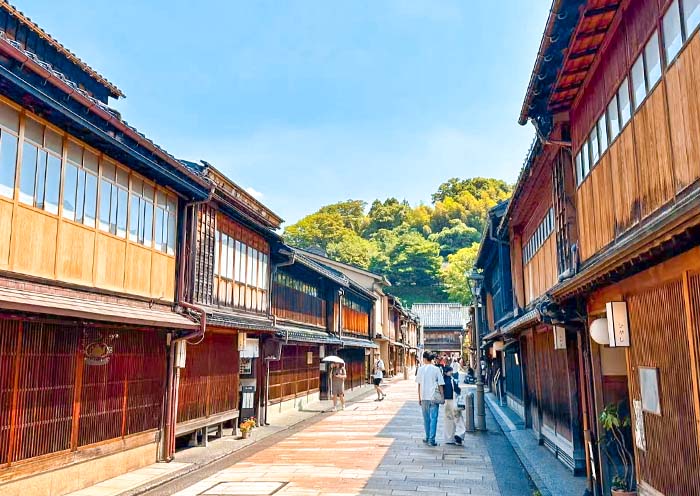
Start your day with a visit to one of Kyoto's most iconic sights, Kinkakuji Temple (Golden Pavilion) - a UNESCO World Heritage site. This Zen Buddhist temple is famous for its stunning golden exterior. The temple's stunning visual appeal comes from its top two floors, which are completely covered in gold leaf. The reflection of the golden structure shimmering in the pond in front of it, makes it perfect for photos and quiet reflection. It was originally built in 1397 as a retirement villa for Shogun Ashikaga Yoshimitsu. After Yoshimitsu's death, as per his will, the villa was converted into a Zen temple by his son.
Next, visit Kiyomizudera Temple, a UNESCO World Heritage Site. Perched on the hillside of Eastern Kyoto, this temple is renowned for its wooden stage that juts out over the hill, providing stunning views of the city and the surrounding nature. The temple's main hall, constructed entirely without the use of nails, is an architectural marvel. Kiyomizu-dera is also celebrated for its sacred waters, which are believed to have wish-granting powers that draw countless visitors who come to drink from its stream. Don’t miss the Hondo (Main Hall), Jishu Shrine, the Otowa Waterfall, and the spiritual experience of the Tainai-Meguri room.
Tips: The scenery at Kiyomizu-dera Temple is distinctively beautiful in each season, offering a unique charm year-round. In spring, the mountains are adorned with charming cherry blossoms; in summer, they are lush with vibrant greenery; in autumn, they are decorated with brilliantly colored leaves; and in winter, they are filled with enchanting trees.
Then, walk up the well-preserved streets of Ninenzaka and Sannenzaka. These charming, sloping streets are lined with traditional shops and quaint tea houses, offering a nostalgic glimpse into Kyoto's past. As you stroll through these areas, you can shop for unique crafts, sample local snacks, and perhaps stop at a café to relax and soak in the atmosphere of old Kyoto.
Next, move to Gion which is Kyoto's famous geisha district. Here, you might catch a glimpse of Geisha (Geiko) in their elaborate kimonos and traditional makeup. As you wander through the cobblestone streets of Gion, take a moment to appreciate the beautifully preserved machiya (wooden townhouses), ochaya (teahouses), and exclusive ryotei (traditional Japanese restaurants). Gion is particularly enchanting at dusk when the lanterns are lit and geishas and maiko (apprentice geishas) make their way to evening appointments, making the narrow lanes come alive.
Continue to Maruyama Park for viewing Sakura. Located near Kiyomizu-dera Temple and Gion District, Maruyama Park is renowned for its stunning display of sakura, particularly the iconic weeping cherry tree (shidarezakura) near the shrine. The park is home to Yamataka-no-Otoko Shrine, a popular Shinto shrine that attracts many visitors throughout the year.
Stay overnight in Kyoto.
Optional Activities:
1. Join a Geisha Experience. It offers a chance to see a performance by a geisha, experience the tea ceremony, and learn all about its artful rituals.
2. Kyoto traditional kimono experience. Wear a traditional kimono and stroll through scenic districts like Gion or around Kiyomizu-Dera Temple. Enjoy photo opportunities and the feel of traditional Japan.
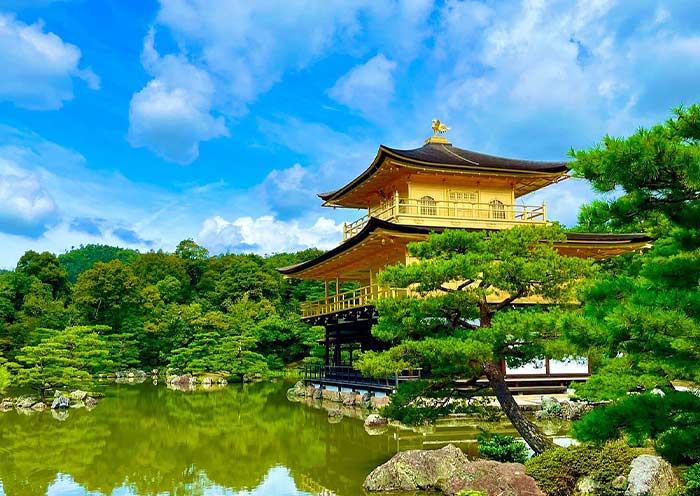

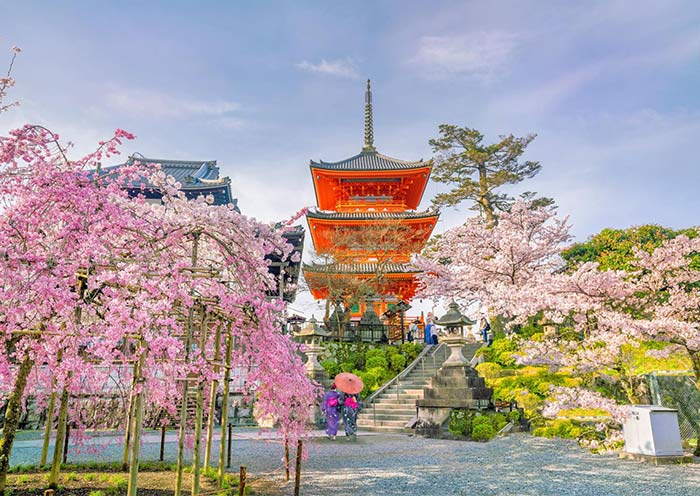

Start morning in Kyoto bright and early at one of its most iconic sites - the Fushimi Inari-taisha Shrine to beat the crowds.
Fushimi Inari-taisha Shrine is famous for its thousands of vermilion torii gates, known as Senbon Torii (thousands of torii gates). Layers upon layers of vermilion torii gates line the lush, wooded hillside, forming a seemingly endless corridor. The vibrant orange and black gates contrast beautifully with the surrounding greenery, creating a visually stunning and almost otherworldly path that is highly photogenic.
Fushimi Inari-taisha was founded in the early 8th century (711 AD) and is primarily dedicated to Inari, the Shinto god of rice, fertility, sake, agriculture, and industry. As you explore the shrine, you will encounter hundreds of fox statues. Said to be the messengers of the god Inari, who is associated with cereal grains, these fox statues often symbolize the deity. Many of these fox statues are depicted holding a key in their mouths, which is said to open the granary.
Tips: Hiking to the summit of the mountain and back will take two to three hours, but many people go only as far as the Yotsutsuji intersection because there are fewer torii gates beyond this point. It will take 30 to 40 minutes to reach Yotsutsuji.
Depart from Kyoto and head to Nara, an approximately 1.5-hour car ride. Before Kyoto, there was Nara, Japan’s first permanent capital and one of the country’s most rewarding destinations. Nara boasts 8 World Cultural Heritage sites, making it Japan's second most culturally rich city after Kyoto.
Visit Todaiji Temple, one of Japan's most historically significant temples and a UNESCO World Heritage Site. It is known for housing the world’s largest bronze statue of the Buddha Vairocana, which stands just over 16m high and consists of 437 tonnes of bronze and 130kg of gold. It represents Vairocana Buddha and is flanked by two Bodhisattvas. Todaiji's main hall, Daibutsu-den (Big Buddha Hall), is one of the world's largest all-wood buildings, even though the present reconstruction of 1692 is only two-thirds of the original temple hall's size.
Walk to Nara Park. This park is famous for its hundreds of freely roaming deer, considered messengers of the gods in Shinto tradition. Purchase some shika senbei (deer crackers) to feed the deer and enjoy Cherry Blossom as you stroll through the park.
Head to Kasuga Taisha (Kasuga Grand Shrine), Nara’s most celebrated Shinto shrine, another UNESCO World Heritage Site. It is renowned for its lanterns, which have been donated by worshippers. Hundreds of bronze lanterns can be seen hanging from the buildings, while thousands of stone lanterns line its approach and the surrounding woods. These lanterns are lit twice a year during the Lantern Festivals in February and August, creating an ethereal and mesmerizing atmosphere.
Hike up Mount Wakakusa (Wakakusa Yama), from where you can enjoy panoramic views of Nara and its surroundings. The hike is relatively easy and offers a great opportunity to relax and take in the natural beauty of the area. The real thrill is that you may encounter friendly deer. The mountain is especially beautiful during the cherry blossom season and autumn when the foliage changes color.
After the tour, drive to Osaka (typically takes around 45 minutes to an hour) and stay overnight.

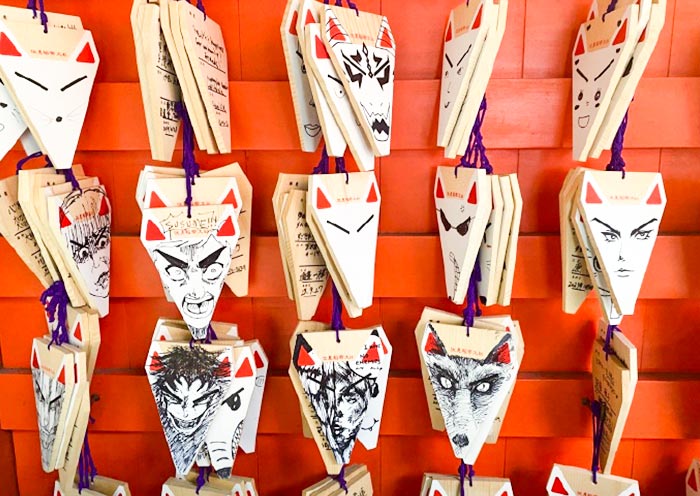
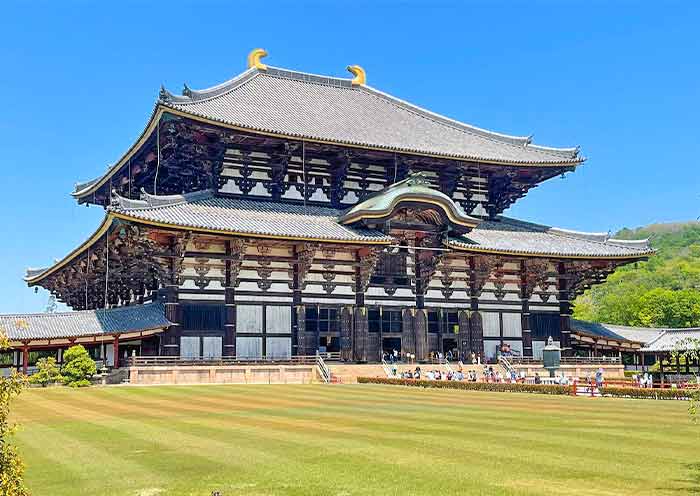

Osaka, Japan's third-largest city and a major economic hub, is renowned for its rich history, diverse cuisine, distinctive culture, and robust economic strength. The city's unique sense of humor and open personality make it an exceptionally interesting place, more colorful than most cities. Acres of concrete are covered with dazzling neon lights and brightly colored storefronts. Osaka is a city that loves to eat, known as the "nation's kitchen." It boasts a wide variety of culinary delights.
Start your day at Osaka Castle Park, one of Japan’s most famous landmarks and a symbol of Osaka’s historical grandeur. Originally built in 1583 by Toyotomi Hideyoshi, a powerful daimyo who aimed to unify Japan, it was the largest castle of its time. After multiple renovations and reconstructions, today's Osaka Castle has been transformed into an open park, covering a total area of 105.6 hectares, making it a must-visit attraction.
Walking into the scenic area of Osaka Castle, you'll be amazed by the massive scale and precision of the moats, gates, and stone walls. The largest stone slab is 11 meters wide, and many stones are inscribed with the crests of the 64 daimyō (feudal lords) tasked with the castle’s construction back in 1620. The most breathtaking feature is the Main Tower (Tenshukaku) of Osaka Castle, which stands tall against the sky at the center of the extensive castle grounds. The castle tower's interior is a museum showcasing artifacts related to Toyotomi Hideyoshi and the castle's history. The observation deck on the 8th floor offers a panoramic view of Osaka Castle Park and the Osaka Plain.
Optional Activity: Take some time to stroll through the Nishinomaru Garden, which offers a picturesque setting with over 600 cherry trees and beautiful views of the castle tower from below. This is especially enchanting during the cherry blossom season, which usually occurs in late March and/or early April.
In the afternoon, you will experience the unique charm of the city through a street food and shopping tour. Enjoy shopping at Shinsaibashi-suji Shopping Street, Osaka's busiest shopping arcade. Then, head to the lively district of Dotonbori, where waterways are lined with luminous advertisements and signs. It's especially glitzy during the holiday season, with decorations strung across the bridges. Full of fantastic restaurants, clubs, and karaoke bars, it's the city's go-to area for entertainment. Take a photo at the iconic Glico Man sign. Try takoyaki, ball-shaped octopus bites, kushikatsu (Japanese deep-fried skewered meat and vegetables), and okonomiyaki, a savory Japanese pancake topped with whatever you like.
Optional Activities:
Kamigata Ukiyoe Museum offers a fascinating glimpse into the traditional Japanese art form of ukiyo-e.
Shinsekai (New World) & Tsutenkaku Tower: Shinsekai, meaning "New World," is a nostalgic and unique shopping district in Osaka, known for its retro vibe, old-school charm, and vibrant atmosphere. Originally built in 1912, Tsutenkaku Tower offers views of the Osaka skyline and is located in the retro-themed Shinsekai area.

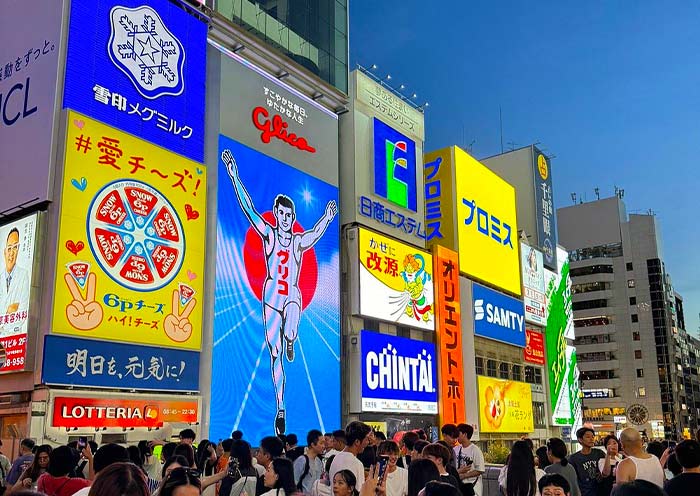
It is time to end your 12 Days Japan Sakura Tour. You will have some free time in Japan to explore further on your own until your driver escorts you to the airport for your flight to your next destination.
If you prefer to travel longer in Japan, you can extend your Japan Tour to other highlighted parts of Japan, such as Hiroshima, Hokkaido, etc.
Thank you for choosing Asia Odyssey Travel (AOT) for your Asia Tour. We are always here working for you and hope to see you again on your next trip to Asia. Safe journey!
What’s Included & What’s Excluded
What's Included:
What's Excluded:
Important Travel Tips for Visiting Japan
Get the right visa. Depending on your nationality and the length of your stay, you may need to apply for a visa in advance. You can do this online or at a Japanese embassy or consulate. Many countries are part of Japan’s visa exemption program, allowing their citizens to enter Japan for short stays without a visa for tourism. Always check if your country is on this list before applying for a visa. If you have any questions, feel free to contact our travel experts for more information.
The best time to visit Japan depends on your interests:
Spring (March to May): Ideal
for witnessing the cherry blossoms and enjoying mild weather. Major cities like Tokyo, Kyoto, and Hiroshima
are particularly beautiful as cherry trees bloom spectacularly.
Summer (June to
August): Perfect for experiencing vibrant festivals such as Gion Matsuri in Kyoto,
Tanabata Matsuri across the country, and enjoying the natural beauty of Hokkaido, which is less humid than
the rest of Japan. Note that early summer (June) is the rainy season.
Autumn (September to
November): Offers stunning fall foliage, making it a great time for hiking and temple
visits. The weather is cool and pleasant, ideal for outdoor activities.
Winter (December to
February): The best time for winter sports, especially in regions like Hokkaido and the
Japanese Alps. Onsens (hot springs) are also a popular attraction during the cold months.
Bring Cash. Despite advances in digital payment, many smaller vendors, temples, and rural
areas operate predominantly with cash. It’s wise to keep some yen on hand at all
times.
Universal Travel Adapter. Japan uses 100V with two straight thin
pins.
Passport: Ensure it’s valid for at least six months beyond your date
of travel.
Visa (if required): Make sure you have the right visa for your
travel.
Travel Insurance Information: Always good to have on hand.
Bow when greeting: A slight bow is a common way to say hello, thank you, or
sorry.
Be mindful of your noise level: Japanese culture values quietness,
especially in public transportation and residential areas.
Follow the rules: Whether
it's waiting in line or adhering to signage, following local rules and etiquette is highly
valued.
Etiquette in temples and shrines: Wear modest clothing and follow specific
customs such as washing hands and mouth before entering a shrine or temple. Photography might be restricted
in sacred areas.
Looking for more travel guides for first-time visitors to Japan? Want to gather additional information to plan your trip? Our team of professional travel experts has written over 40 articles about Vietnam. Please check out ourJapan Travel Guide for inspiration and detailed insights.
Hotel Conditions for Your Japan Tour
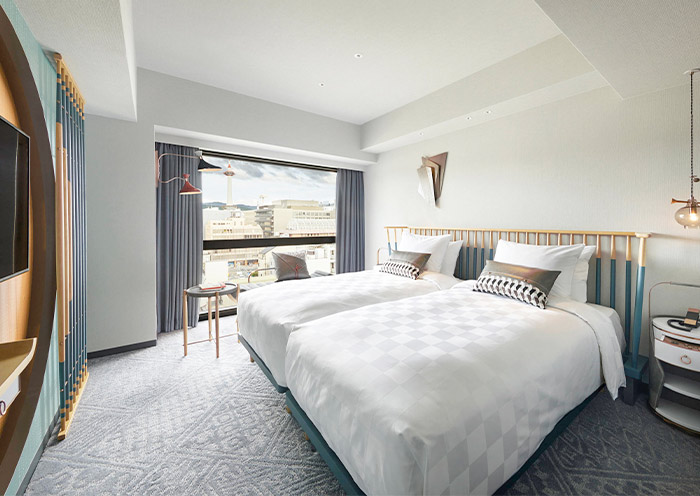


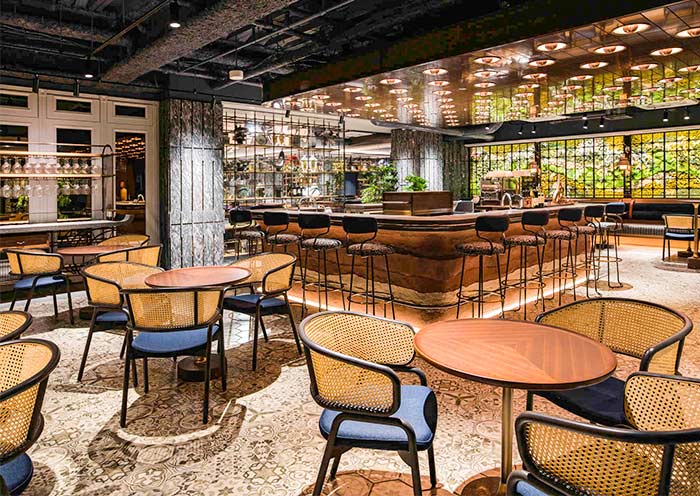
We offer a range of accommodation options to suit various preferences and budgets: luxurious 5-star hotels, comfortable 4-star hotels, and economical 3-star hotels. Our selected hotels are conveniently located close to the city center or popular tourist spots.
For those seeking a more distinctive lodging experience, we also offer Traditional Ryokans, Machiya, Onsen (hot springs) Hotels, etc. If you have specific needs or preferences, please consult with your travel advisor.
Tips: Be aware that hotel room sizes in Japan may be smaller compared to those in other developed countries due to the scarcity of land. If your budget allows, it is recommended to opt for a higher category of hotel, which will generally offer more comfort.
Photo Gallery for This Itinerary
Latest Japan Tours Reviews from Our Customers

Jess
Malaysia
Destination(s): Beijing, Xian, Shanghai, Zhangjiajie
Date of Experience: Sep 04, 2025
Tour Customized by: Yee
You May be Interested in This Tour: 26 Days In-Depth Vietnam China Japan Tour: Ultimate Asia Contrast

Claudia Konrado
Brazil
That’s when a friend recommended Asia Odyssey Travel (AOT), and it was the best decision we made! Not only did they completely customize our entire trip, but they did so at a perfectly reasonable cost. Our travel agent, Abby, was absolutely incredible. She worked tirelessly with us to build out an itinerary, patiently answering all our questions, offering guidance, making changes, and adding new ideas with such care and professionalism. From Disney and Universal for the teens to visits to TeamLab Planets, museums and temples and shopping excursions, ending with a relaxing beach time in Okinawa, Abby worked with us and ensured there was something wonderful for everyone. Even during the trip, she was always available to help and provide support. I truly can’t express how much Abby made a difference in our experience. The entire team at AOT, from the guides to the drivers, was consistently helpful and attentive, ensuring every moment of our journey was smooth and enjoyable. We are so grateful for the wonderful memories created, all thanks to the dedication and expertise of AOT team. We highly recommend them for an exceptional travel experience.
Date of Experience: Jul 01, 2025
Tour Customized by: Abby
You May be Interested in This Tour: Customized Tour

Cheers
Britain
I’m so glad we chose to do this tour! We were looking for a way to escape the summer heat, and Hokkaido was a dream come true. The air was so fresh and the scenery was just incredible—I swear my photos don’t even do it justice.
The highlight for me was definitely the lavender fields in Furano. They were even more beautiful in person than in all the pictures you see online. Our private guide knew the best spots to get a great view without fighting the crowds. Plus, we got to see all the other rainbow flower fields in Biei which were just as amazing.
The trip was super relaxing because we didn't have to worry about a thing. Our driver was so professional, and it was a huge relief to have a private car just for our family. It made getting between all the different towns so easy. We loved exploring the charming canal in Otaru and getting to eat all the fresh seafood in Sapporo. The food in Hokkaido is seriously on another level!
Date of Experience: Jun 10, 2025
Tour Customized by: Cheers
You May be Interested in This Tour: 8 Days Hokkaido Summer Tour: Colorful Family Vacation on Hokkaido Island
Price: From USD request pp
(Based on a private tour for 6 persons staying in 4-star hotels. Prices may vary depending on the itinerary, travel dates, and group size. )
(Book at least 6 months in advance)

